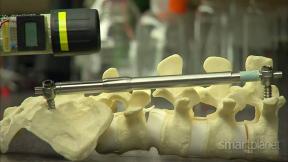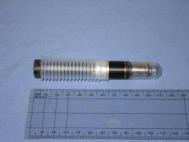Roboimplant
The Problem
 Adolescent Idiopathic Scoliosis is a curving of the spine. The spine curves away from the middle or sideway. If the curvature is severe, bracing and surgery may be necessary. Currently rods and screws are placed on the spine during surgery to slowly restore the spine to a normal position. The repair takes years and involves as many as eight operations to adjust the rods to the desired configuration. This can be a very painful process for the child and in some cases the results are anything but acceptable. Currently there are approximately 33,000 children who undergo the surgery in the US alone.
Adolescent Idiopathic Scoliosis is a curving of the spine. The spine curves away from the middle or sideway. If the curvature is severe, bracing and surgery may be necessary. Currently rods and screws are placed on the spine during surgery to slowly restore the spine to a normal position. The repair takes years and involves as many as eight operations to adjust the rods to the desired configuration. This can be a very painful process for the child and in some cases the results are anything but acceptable. Currently there are approximately 33,000 children who undergo the surgery in the US alone.
The Solution
 This device called Roboimplant uses magnetic coupling and remote pressure sensing. Roboimplant can lengthen or shorten a rigid implanted rod without further surgery in the doctor’s office. The physician can monitor the movement of any rigid rod device and the pressure exerted on the patient’s spine. The device has 6mm universal attachments at each end that can tell the orthopedic surgeon to attach a variety of rigid rods and screws. Once attached, Roboimplant can be controlled to place tension on the rods and slowly change the shape of the patient’s spine.
This device called Roboimplant uses magnetic coupling and remote pressure sensing. Roboimplant can lengthen or shorten a rigid implanted rod without further surgery in the doctor’s office. The physician can monitor the movement of any rigid rod device and the pressure exerted on the patient’s spine. The device has 6mm universal attachments at each end that can tell the orthopedic surgeon to attach a variety of rigid rods and screws. Once attached, Roboimplant can be controlled to place tension on the rods and slowly change the shape of the patient’s spine.
 There is an external controller which spins a magnet in such a way as to expand or contract the implant. This will put additional pressure on the rods attached along the spine. This device can also monitor the force exerted by the implant and thus determine the correct amount of weekly adjustments.
There is an external controller which spins a magnet in such a way as to expand or contract the implant. This will put additional pressure on the rods attached along the spine. This device can also monitor the force exerted by the implant and thus determine the correct amount of weekly adjustments.
We are also working on modifying the device for use in leg-lengthening procedures.
The market for this device would be in the thousands of patients per year. We have implanted the device in an animal model and have refined the size and strength of the device. The device may also have applications for leg lengthening and jaw repair.
Treating scoliosis in kids with magnets - YouTube
Under Development
Roboimplant has received a patent from the United States Patent Office.
Roboimplant has just been completely re-designed. We have completed. We will need help in modifying the design to meet increased force requirements to reconfigure the spine. We will also need assistance in modifying the external control device to more effectively monitor minute force changes in the patient’s spine.

